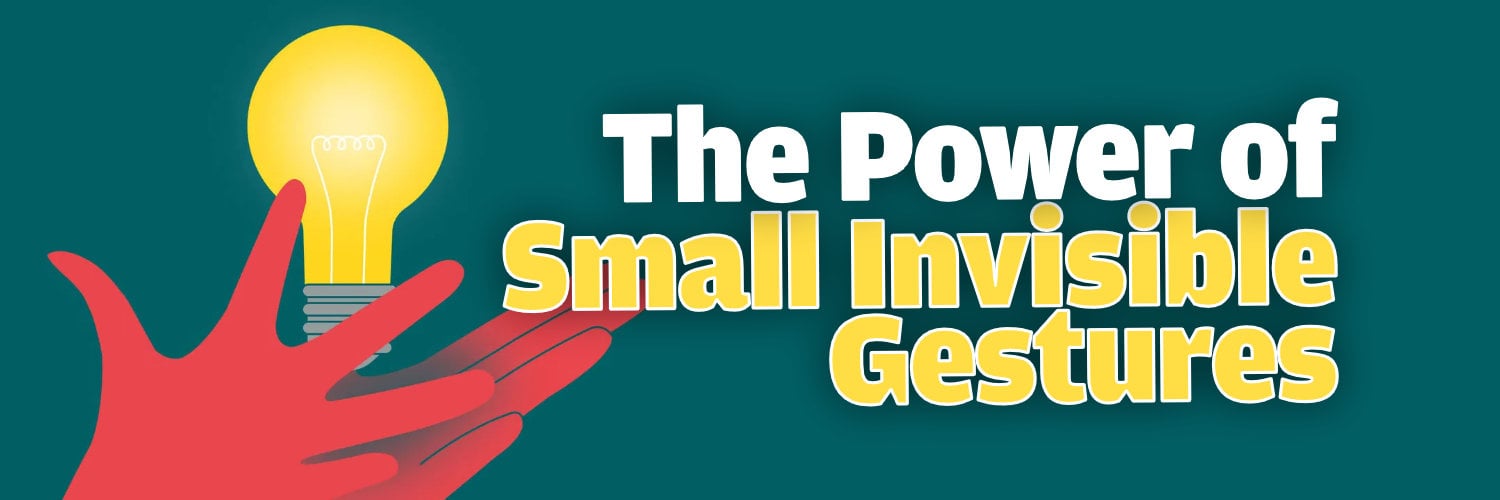
The Power of Small Invisible Gestures
It's the small things you do for others that seem insignificant to most people but not to the people that matter.
I read a few articles a couple of weeks ago following the death of Jack Twyman. I had never heard of of him before, but after reading about his life and what he did it is a story worth sharing. In a day and age where Charles Barkley said it

I read a few articles a couple of weeks ago following the death of Jack Twyman. I had never heard of of him before, but after reading about his life and what he did it is a story worth sharing. In a day and age where Charles Barkley said it best, “I’m not a role model”. Jack Twyman was a role model. Here is his story.
If Jack Twyman had his way, you wouldn’t be reading this. He never sought attention, like the time he met NBA All-Star Allan Houston.
The Knicks’ guard was at a golf course, waiting to tee off. Twyman was in the next foursome, and he decided to go over and shake Houston’s hand.
“I really admire you as a player and a professional,” Twyman said.
Houston was cordial, but he couldn’t tell the old man from thousands of other admirers over the years. Then he noticed the ring Twyman was wearing.
“His eyes got so wide,” recalled Jay Twyman, Jack’s son.
It was a Hall of Fame ring, Class of ’83. It turns out Houston was the one who should have been shaking Twyman’s hand.
The old guy’s story has been seeping back into the news. Twyman passed away Wednesday night at a Cincinnati hospice. He was 78, and it’s sad he had to die for most of us to remember him.
“It’s something that happened so long ago,” Jay said. “I think a lot of people have forgotten about it.”
Not everybody.
It was 1958. A 23-year-old white guy basically adopted a paralyzed 24-year-old black man.
Maurice Stokes played with Twyman on the Cincinnati Royals. They’d come in together as rookies three years earlier. Twyman was a skinny swingman from the University of Cincinnati with a deadly shot.
In 1959, he became the first player besides Wilt Chamberlain to average more than 30 points a game. Twyman would probably rank as one of the top couple hundred players in NBA history.
Stokes was on his way to the top 10 until the night of March 12, 1958.
“He was Karl Malone with more finesse,” Bob Cousy once said.
He was 6-foot-7 and 250 pounds of athleticism that had rarely been seen. Stokes had 32 points and 20 rebounds in his first pro game. He made the All-Star team his first three seasons, averaging 17.7 rebounds a game.
In the last game of the regular season, Stokes went skyward and fell backward over another player. The back of his head slammed the court, knocking him cold.These days, Stokes would have been immobilized and rushed to the hospital. In 1958, he was given smelling salts and sent back in.
Stokes did his duty that night. He played the first game of playoffs three days later. On the flight back from Detroit, the big man started shaking and sweating. He had a seizure and went into a coma.
An ambulance was waiting at the Cincinnati airport. Stokes had suffered post-traumatic encephalopathy. The blow had damaged the part of his brain that controls motor function.
He would never walk again. At first, all he could do was blink.
“How would you like to be one of the premiere athletes in the world on a Saturday,” Twyman recalled. “Then on Sunday, you go into a coma and wake up totally paralyzed, except for the use of (your) eyes and brain? I mean, can you imagine anything worse?”
No, unless you throw in a red-tape nightmare and no idea how to pay for a lifetime of medical bills.
Again, this was 1958. NBA stars didn’t have comprehensive medical coverage, much less entourages and Bentleys.
Stokes had $9,000 in his bank account. He was single, and what family he had was in Pennsylvania and in no financial shape to help.
Twyman applied to become Stokes’ legal guardian. A judge granted the request. That allowed Twyman to handle the bills, apply for workman’s compensation and chop through the paperwork.
Twyman was far more than Stokes’ bookkeeper, however. He eventually had four children, and Stokes was almost as much a part of his life as any of them.Again, this was 1958. That didn’t matter.
“There was no defining a person by the color of their skin,” Jay said. “He basically adopted Maurice.”
Twyman would sit by Stokes’ bed, calling out letters. When he got to the right one, Stokes would blink. That’s how they built words and shared conversation.
Twyman spent so much time with Stokes, he worried that he was ignoring his own family. He would bring his wife, Carol, and kids to visit his friend.
Carol became co-trustee of the Maurice Stokes Foundation. Her husband started it to defray Stokes’ medical bills. It eventually expanded into a charity that helped other NBA veterans.
It took years, but Stokes slowly regained some movement in his upper body. It took countless hours of rehabilitation. As hard as it was, Stokes never seemed to have a bad day.
He was given a makeshift typewriter one day. With trembling fingers, he typed a short note.
“Dear Jack, How can I ever thank you?”
Twyman felt he was the one who owed Stokes.
“I just stood in awe of him,” Twyman said. “When I would be having a bad day myself, I would go to see Maurice, selfishly, to say, I want to get pumped up. And he never failed to pump me up.”
Their relationship endured until 1970, when Stokes died of heart failure. He was 36 years old.
Twyman went on to make a fortune in the insurance and grocery businesses. He was an analyst for ABC. From the way he carried himself, you’d have never known he was anything special.
He’d given away almost all his trophies and awards. The ring Houston spotted that day on the golf course was one of the few clues to greatness.
“I cannot overemphasize what a humble guy he was,” Jay said of his father. “He was very caring. If you spent any time with him, he made you feel very special.”
It was that way until the end. This past weekend, Twyman wanted his children and grandchildren to come to Cincinnati. The battle he’d waged against an aggressive form of blood cancer was about over.
“He knew what was going on,” Jay said. “But he said, ‘Listen, I don’t want to make this a sad weekend. I want everybody to celebrate.’ ”
They told stories and jokes and watched the NBA playoffs. Twyman’s admiration for talent never faded.
“Boy, that Duncan!” he said watching the Spurs. “I can’t believe how strong he is running up and down the court.”
Tim Duncan might have reminded Twyman of someone he once played with. It was so long ago, most people don’t even recall the guy’s name.
We’ll never know how great Maurice Stokes would have been.
We do know he had the best teammate in NBA history.
===> Interact and learn with 250+ of the best microcap investors on the planet. [Join Us]
MicroCapClub is an exclusive forum for experienced microcap investors focused on microcap companies (sub $500m market cap) trading on United States, Canadian, European, and Australian markets. MicroCapClub was created to be a platform for experienced microcap investors to share and discuss stock ideas. Since 2011, our members have profiled 1000+ microcap companies. Investors can join our community by applying to become a member or subscribing to gain instant view only access. MicroCapClub’s mission is to foster the highest quality microcap investor Community, produce Educational content for investors, and promote better Leadership in the microcap arena. For more information, visit http://microcapclub.com and https://microcapclub.com/summit/
Get Alerted to our Next Educational Blog Post

It's the small things you do for others that seem insignificant to most people but not to the people that matter.

During the journey nothing seems to make sense because you are living through it in the present. It’s only when you stop and look back when it all makes sense.

Becoming a full-time private investor is the pinnacle of financial achievement. Why? You don’t need the help of others for anything. You don’t need a boss. You don’t need clients. You don’t need customers. You don’t need their money. You have your own.